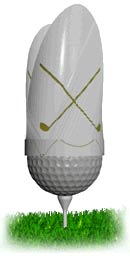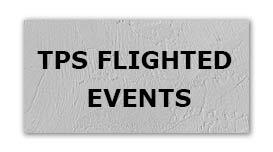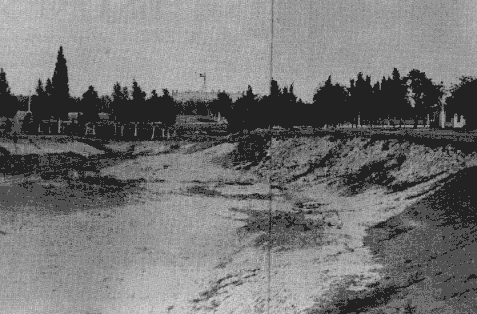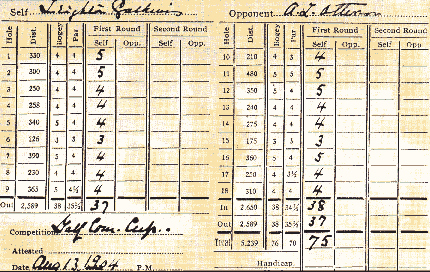|




|
THIS ONE'S A PAR 4 �
An old concept, half par gave a new meaning
to halving a hole. What are half pars?
Why don't we use this anymore?
by Dean Knuth
AT THE TURN of the century, you might have found yourself playing a course where more than one hole bore a par of 3�, 4�, or 5�. The concept left an impact on Course Rating in the United States that has never been adopted in Europe � the use of fractional USGA Course Ratings instead of whole numbers. Today your course might have a USGA Course Rating of 70.6, not an even 70 or 71 as it would be in Europe.
 Around 1901, golf holes were assigned par ratings of 3, 3�, 4, 4�, 5, 5�, or 6, depending on their length and design. For example, the Country Club of Atlantic City, a popular links course at the turn of the century, was 5,879 yards long, and had a "par score" of 72�; par on the 7th, 8th, and 9th holes was set at 3�, 4�, and 4�, respectively. Aronimink Golf Club in Philadelphia in 1903 was a nine hole course with a total length of 3,060 yards. Its pars ran 4, 4, 3�, 5�, 3�, 4, 4, 4, 4, totaling 36�. (Ah, the good old days. Initiation fees were $20, and annual dues also $20.)
Around 1901, golf holes were assigned par ratings of 3, 3�, 4, 4�, 5, 5�, or 6, depending on their length and design. For example, the Country Club of Atlantic City, a popular links course at the turn of the century, was 5,879 yards long, and had a "par score" of 72�; par on the 7th, 8th, and 9th holes was set at 3�, 4�, and 4�, respectively. Aronimink Golf Club in Philadelphia in 1903 was a nine hole course with a total length of 3,060 yards. Its pars ran 4, 4, 3�, 5�, 3�, 4, 4, 4, 4, totaling 36�. (Ah, the good old days. Initiation fees were $20, and annual dues also $20.)
Where did the half-par come from? What happened to it? Even using the extensive research library at Golf House, the answer is difficult to pinpoint. But it seems to have been developed by the top amateur of the day, Walter J. Travis, at his home club, Garden City G.C. on Long Island. Travis had a monthly column in Golf and showed a great interest in handicapping; in fact one Travis column in 1901 was the authoritative treatise on handicapping until Leighton Calkins formalized a procedure in 1907 that was adopted by the Metropolitan (NY) Golf Association, then by the USGA in 1911.
In his 1901 article, Travis praised the Metropolitan Golf Association's decision to have its member clubs establish par as a course rating standard so that players' handicaps could be more comparable from club to club. Prior to this decision, each club had established its own "Bogey" based on how its best player scored. Bogey simply represented the score of a good player who made mistakes. In essence, a club's best player was a scratch player; the other members' handicaps were compared to that player.
The practice made handicaps comparable within a club, but, as Travis wrote, "A scratch player at Stumpville may conceivably be entitled to a handicap of nine strokes from a scratch man at Bunkerville... and adds materially to the difficulty of placing all the competitors on an equal footing.... By far the better plan, however, is to take as a basis the par � not the bogey � of the course, which is a fixed quantity."
"Par golf is perfect golf, determined according to the distances of the holes and with two strokes allowed on each green.... The Metropolitan Golf Association has accomplished very good work by classifying all the players of the various clubs in the association up to the limit of 18 strokes. The handicaps are fixed at the beginning of the season, and, necessarily, are based upon the performances of the preceding season." Travis also stressed the importance of the work of the club Handicap Committee, and concluded his article with a caution that, "the mutability of the game of the average player makes it impossible to reduce any system of handicapping to an exact science � and it is perhaps just as well that it is so."
As a result of this changeover to the use of par, par rating became the first course rating. Today, the USGA Course Rating is issued to a club by an authorized amateur golf association. It represents the expected better-half scoring average of a scratch golfer (who is defined for men, for example, as a player who plays in the stroke-play field of the U.S. Amateur Championship). Par is set by clubs today based on effective playing length:
| Par | Men's Yardage | Women's Yardage |
| 3 | up to 250 | up to 210 |
| 4 | 251 to 470 | 211 to 400 |
| 5 | 471 to 690 | 401 to 575 |
| 6 | 691 and over | 575 and over |
In 1905, however, the Metropolitan Golf Association and Golf Association of Philadelphia were using this yardage table, involving the half-par concept:
| Par | Men's Yardage |
| 3 | up to 200 |
| 3� | 201 to 250 |
| 4 | 251 to 375 |
| 4� | 376 to 425 |
| 5 | 426 to 510 |
| 5� | 511 to 600 |
| 6 | 601 to 650 |
In a 1903 article in Golf by Welton W. Harris entitled "Figuring the 'Par' of Holes," the author voiced a concern that the Metropolitan Golf Association's par guideline "making proper allowance for the configuration of the ground" was too subjective. He proposed that the guiding principle become "when the configuration of the ground is such that a player of the first class cannot make the hole, at least half the time, in the par score for the hole as calculated on length of hole alone, add a half stroke to the estimated par." Harris referred to the first hole at the now-defunct Fox Hills Club: "It is 396 yards long, and by the Metropolitan table would be par 4�. So far as distance alone is concerned, the class player ought to make that hole at least half the time in 4 � two full shots and two putts. Yet at the time of the open tournament at Fox Hills last November, with an entry of over 70 players, including Willie Anderson, George Low, Laurence Aucterlonie, and all the best professionals in the country, and some of the best amateurs, the hole was not made in three and was made only nine times in four, notwithstanding that it was played a total of more than 170 times in two days of play.
"Now in figuring the par of a hole it seems only fair that the class player should have a chance to equal par at least half the time. It is manifestly impossible to make that hole in 4� strokes, therefore to equal par the player must make a 4. As he has no chance on earth to do that, at least half the time, the par of the hole should be 5."

If a hole was too tough for a par of 4, but too easy for a par of 5, what did you do? Make it a par of 4�, that's what. At Garden City G.C.'s 2nd hole, in June of 1900, a voluminous hazard called the Bottomless Pit made the going tough for gutta percha-era golfers
Perhaps because of similar problems with the use of half par, it was eliminated around 1907 when Leighton Calkins became Handicap Committee Chairman of the Metropolitan Golf Association. As I mentioned in the October, 1992, Golf Journal, Calkins adopted a whole-number par rating procedure based on the expected score of the top area amateurs of the time. Not until four decades later did Thomas McMahon of Chicago and, later, Los Angeles, reintroduce fractional par � and it was strictly for Course Rating purposes.
Although hole pars used on scorecards were whole numbers (excuse the pun), golf association rating teams rated courses under McMahon's system by assigning hole ratings such as 3.8, 4.2, and 4.9 to holes. The sum became the USGA Course Rating issued to a tenth of a stroke, just as it is today. But can you imagine playing a 4.2? What's a birdie? A 3.2? Let's be thankful the only fractions we deal with are in Course Ratings; it's hard enough for some golfers to come up with a score using only whole numbers.

If you need final proof of the concept of half par, look at Leighton Calkins's scorecard, noting the 9th and 17th holes.
|






